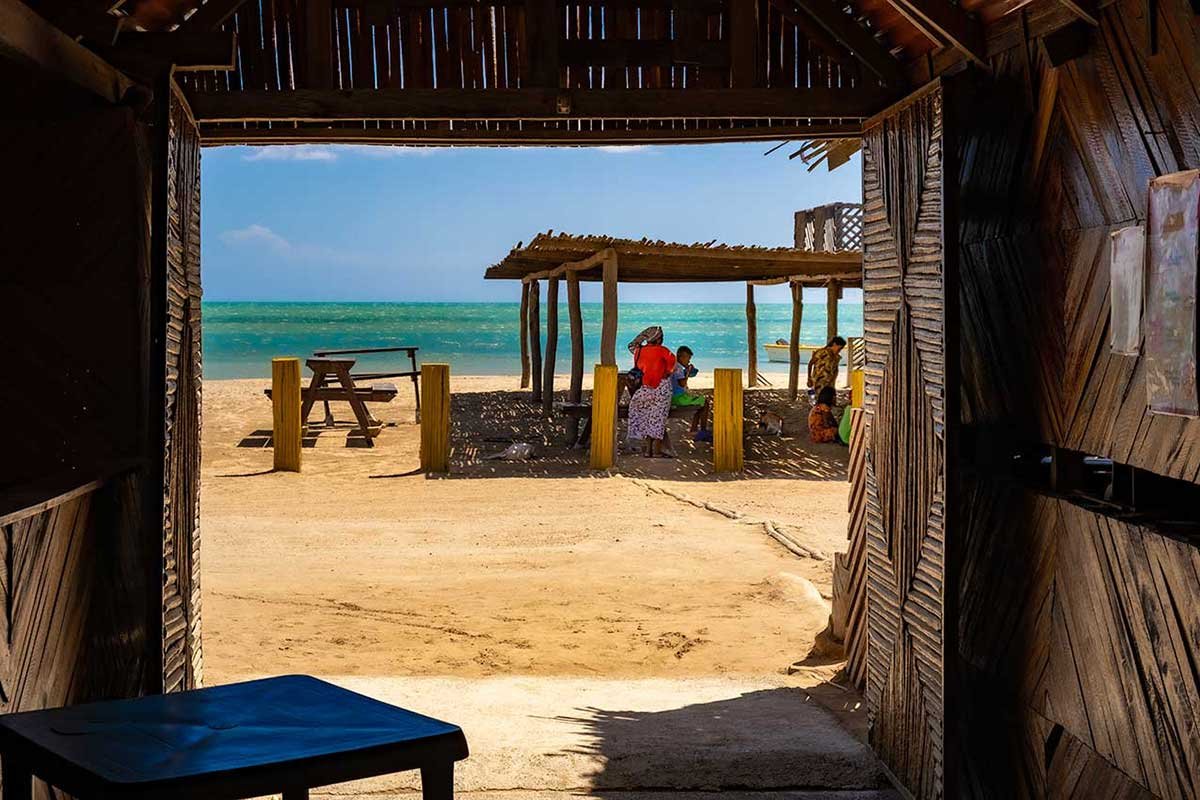How to Visit Cabo de la Vela and Punta Gallinas – All You Need to Know
There is a whole range of epic multiday trips and tours you can do in Colombia. The trek to the Lost City and a 2-day trip to Tayrona National Park are among the most popular.
The Cabo de la Vela and Punta Gallinas located in the Colombian department of La Guajira, however, are still largely undiscovered by foreign travelers and backpackers. Yet this trip was a highlight of my Colombia adventure, and it is definitely one of the best things to do in Colombia. Visiting Cabo de la Vela and Punta Gallinas is one of the most spectacular experiences I’ve had in Latin America! On many levels.
But it is not a trip for everyone.
La Guajira is one of the most extreme parts of Colombia. In many ways!
It is extremely beautiful, but also one of the poorest departments in the country. You will see jaw-dropping vast landscapes, deserts, sand dunes, and stunning beaches that you never knew existed in Colombia. At the same time, you will see people living a hard life under the most extreme conditions.
This trip will put you in awe and make you very uneasy at the same time.
But for me, that is the essence of travel. Seeing the real country. Real life. So if you feel like discovering this incredible yet very troubled part of Colombia, which is La Guajira, then this travel guide is for you!
This blog is supported by you. The content, written with love and passion, will always remain free. My posts may contain affiliate links, which means that I will receive a small commission if you purchase the product or make a booking through one of my links. I will never recommend or promote a product I don’t believe in or haven’t used myself. This way, you support my work at no extra cost to you. Thank you!
Things to know before traveling to La Guajira (Cabo de la Vela)
La Guajira is one of Colombia’s 32 departments and is located in the far north of the country in the Caribbean region. Its capital and main city is Riohacha, and a large part of the population is descended from the indigenous Wayuu people.
It is a geographical and natural wonder, where desert and sea merge into one surreal landscape.
La Guajira’s environment and climate are harsh. The northern part, beyond Riohacha, has desert-like conditions and the climate is hot and dry, so water scarcity has long been a problem.
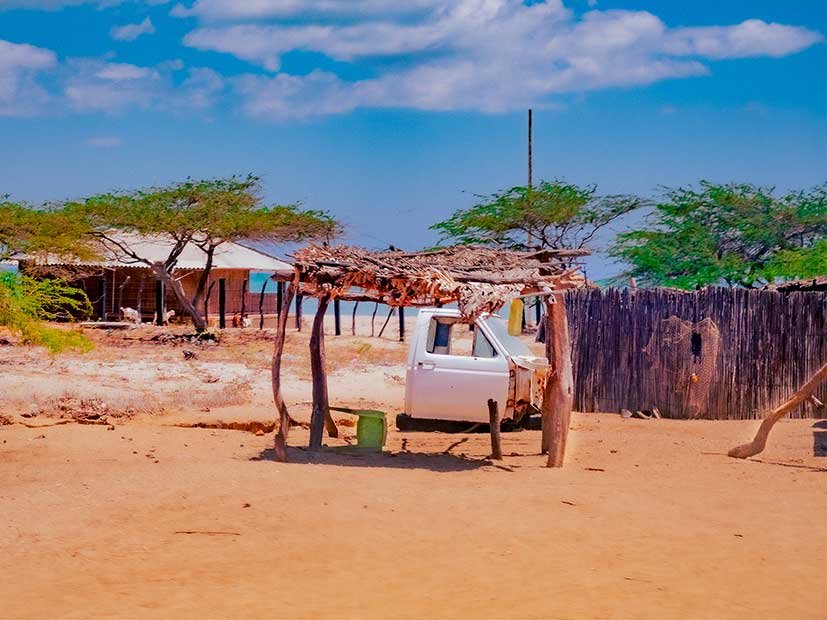
It is a beautiful yet the most impoverished and neglected department of Colombia. La Guajira is home to Colombia’s largest indigenous group, the Wayuu. The Wayuu represent a little over 20% of Colombia’s total Amerindian population and under 50% of the Department of La Guajira population.
Their history is fascinating as the Spanish have never defeated them. Not only that, they learned how to use firearms and horses and fought many battles with the Spanish. Wayuu occupied the harsh environments of the La Guajira desert for centuries. They lived off the land, creating crafts, and passed all their traditions for generations.
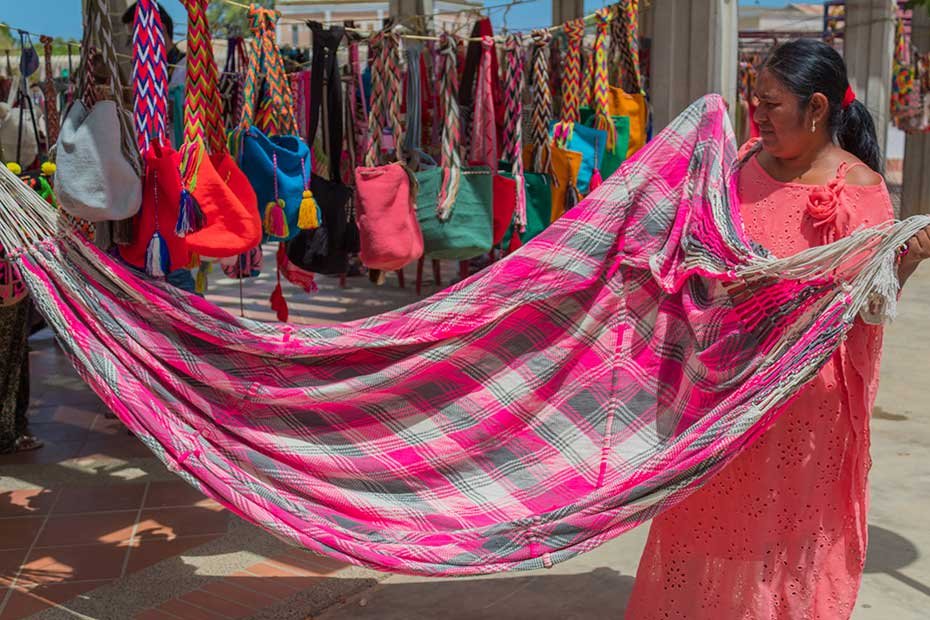
The region suffers from a lack of clean drinking water, and kids are often severely malnourished. More than 60% of the population lacks access to sewage systems, electricity, or water aqueducts.
So you will ask – why visiting Cabo de la Vela or Punta Gallinas? Is it even ethical? Is it safe? Why are you telling me I should go?
Alta Guajira is like no other place in the world, and it is one of those places that need tourists. It has been abandoned by governments and tourism brings in much needed revenue. It’s a harsh region and there is a lot you should know about before you visit, but don’t let that stop you! I was totally fascinated by the landscapes I encountered and will visit again!
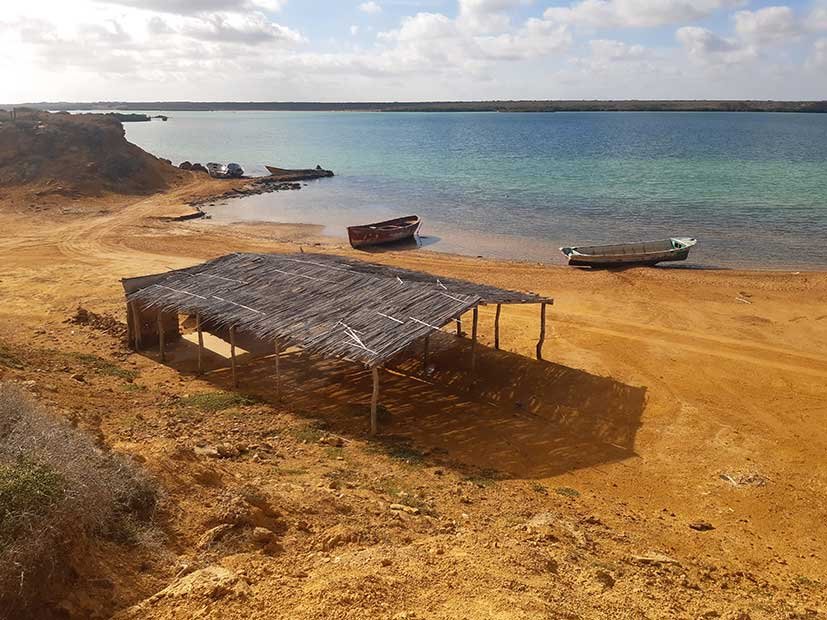
What are Cabo de la Vela and Punta Gallinas?
Cabo de la Vela is a small fishing village that can only be reached by jeep or motorcycle and is located in the La Guajira desert on the eastern Caribbean coast of Colombia. Cabo de la Vela is also known as an excellent place to learn kitesurfing!
Punta Gallinas is the northernmost point of the South American mainland. The landscape of Punta Gallinas is unlike any other landscape in Colombia.
Both places are located in the Alta Guajira and can be reached through the desert. I recommend going on an organized excursion, but you can also visit Cabo de la Vela on your own. Punta Gallinas, however, can only be accesed with a guide. I will provide all the details further in this post.
How much does it cost to take a trip to Cabo de la Vela and Punta Gallinas
The prices for the organized Cabo de la Vella tour vary depending on where you book it. If you get tempted to book well upfront, either online or maybe during your stay in Santa Marta, you will pay more. Those agencies can charge even 300 USD!
I was aware of that and also I was advised to book mine in Riohacha via my hostel or directly with a local agency. And indeed I paid less.
A shared three-day Cabo da la Vela and Punta Gallinas tour with chinchorro accommodation (sleeping in the hammocks), three meals per day, and insurance included should not cost more than 750,000 COP if you book it locally.
This is still a lot! I could only afford to do one tour like this and I sacrificed the Lost City trek for this. It was worth it!
The basic, cheaper tour is with a Spanish-speaking driver. Please be aware that the driver is not a guide. He will answer your questions but really, he will just take you from place to place – which is perfectly fine!
There are a few agencies in Riohacha, you can find them on Google Maps. I recommend checking their reviews and then contacting them directly for the best price.
For English speaking guide and more perks, you will have to pay much more.
Also, expect to pay more for private rooms with a bed. There are also private tour options which are also more expensive.
- You can make it cheaper by opting for a 2 days/1 night tour.
It will cost you around 30.000COP to get to Uribia from Riohacha and then 50.000COP for a 4×4 to Cabo. The chinchorro bed in Cabo de la Vela will cost you 15 to 20.000COP.
You can get some snacks and supplies in Urbia. Lunch in the hostel or rancheria in Cabo will cost between 20.000 and 30.000COP. Same for dinner.
Then the next day you can get a tour to Punta Gallinas which will be much cheaper than the 3-day tour. The return ride should be around 250,000 COP one way and will include a stay at the rancheria. There are rancherias you could stay at but I have not booked it myself so I definitely suggest discussing it with you hostel owners in Cabo de la Vela before you leave. They will be able to advise you on this.
Please keep in mind that if you decide to book a tour this will come with insurance and the agency/tour guide will take some responsibility for your safety. While I wouldn’t say that La Guajira is dangerous, it is definitely tricky. Colombia was my first Latina American country as a solo female traveler and I decided to prioritize my safety and peace of mind. Sometimes at the added cost. The choice is yours.
How to travel to Cabo de la Vela and Punta Gallinas – tour or no tour?
Cabo de la Vela can be visited without a tour or guide but is a very adventurous trip. If you want to see the whole region including Punta Gallinas and places like Bahia Portete or Taroa Dunes, it is better to travel with a tour.
The road leads through the desert and is not always visible and not marked or signposted at all. Along the way, there are many unofficial ‘checkpoints’ set up by the locals where you will be asked for food, water, and ”entrance fees”. This is not a journey you want to undertake on your own.
For this reason, I booked a tour. I wanted to see all the parts that are accessible to travelers in Alta Guajira! I went on an organized 2-night/3-day trip, but I have put together some information for you in case you just want to explore Cabo de la Vela on your own!
Traveling to Cabo de la Vela without the tour
To visit Cabo de la Vela independently you will need to get to Uribia first. It is best to start your journey in Riohacha and then take the bus to Uribia.
Uribia is known as the indigenous capital of Colombia and serves as a cultural center for the Wayuu people. It is by all means not a tourist-oriented town. But it is safe if only you stay careful and use common sense.
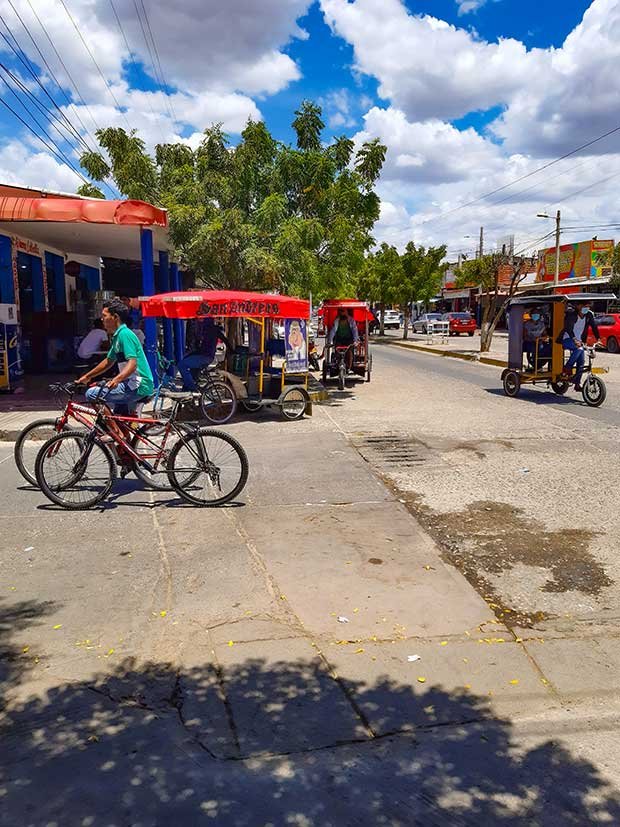
From Uribia you will have to catch a pickup track which will take you to Cabo de la Vela. Head over to the main market where you will find pickup tracks taking people to Cabo de la Vela. If you want to take the collective track be sure to arrive early. I was told the last one leaves at 4 pm. If you choose this transportation be prepared to share the ride with many people and maybe some animals too!
You can also get a 4×4 from the main street where you will find transportation agencies. It is more expensive but definitely more comfortable. The ride costs 50,000COP and takes around an hour and a half.
Once you are in Cabo you can ask for trips to places like Pilon de Azucar or join a tour to Punta Gallinas.
If I were doing this trip again, as a more experienced traveler, I would travel to Cabo de la Vela independently, stay for 2 or 3 nights, and ask around for day trips from there. Cabo de la Vela is so stunning! It is definitely a cheaper option yet keep in mind that if you choose this option, you will have to work a bit to get things organised.
How to book accommodation in Cabo de la Vela (and what to expect)?
If you are fine with sleeping in a hammock you can most likely just arrive and book one there and then. There are a few hostels and rancherias in Cabo de la Vela offering them.
But still, I would definitely recommend checking beforehand. You will be in the middle of nowhere, you want to make sure you have a bed or hammock to sleep in. Vbelasofia and El Viejo Moi Hospedaje & Restaurante can be booked via Booking.com. Rancheria Utta is a bit further away from the ”center” but has excellent reviews and comfortable double rooms.
Hostal Analauli is a great budget choice and can be contacted here and Estrella Del Mar Cabo de la Vela here.
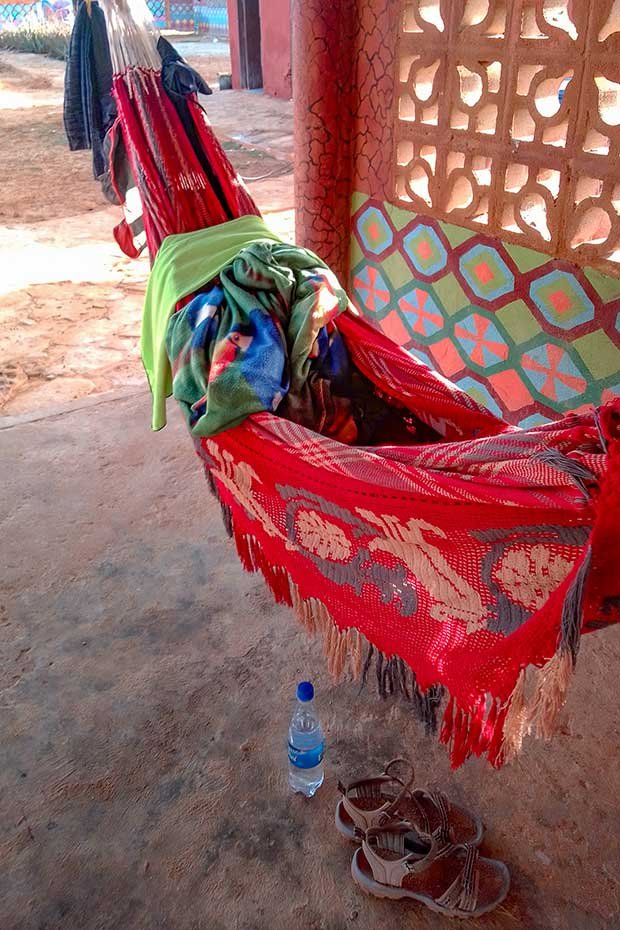
The rancherías are villas built by the Wayuu people, set in the middle of the desert. In them, you will sleep in the famous hammocks (chinchorros) – hand-woven by Wahuu, which are larger and more comfortable than regular hammocks. However, it is possible to sleep in a bed with a private bathroom for an additional fee.
The rancherías have public bathrooms, and due to a shortage of water and electricity around the region, you might have a couple of hours window in the morning and one in the evening for a shower and electricity will be turned on for few hours in the evening only. Power bank is a must!
The hammocks (chichorros) are so comfortable I was surprised! They are spacios and warm and i highly recommend it! Its a great experience.
Taking Cabo de la Vela and Punta Gallinas tour
The typical Cabo de la Vela and Punta Gallinas organized trip lasts 3 days/2 nights. There are 2 days options but those will omit Punta Gallinas. This region is vast and impossible to see in one day.
On day one you will head towards Cabo de la Vela where you will spend your first night. This place is just magical! You will sleep in one of the beachside ”hotels” where you will get your hammock and a locker. You will wake up to this view:
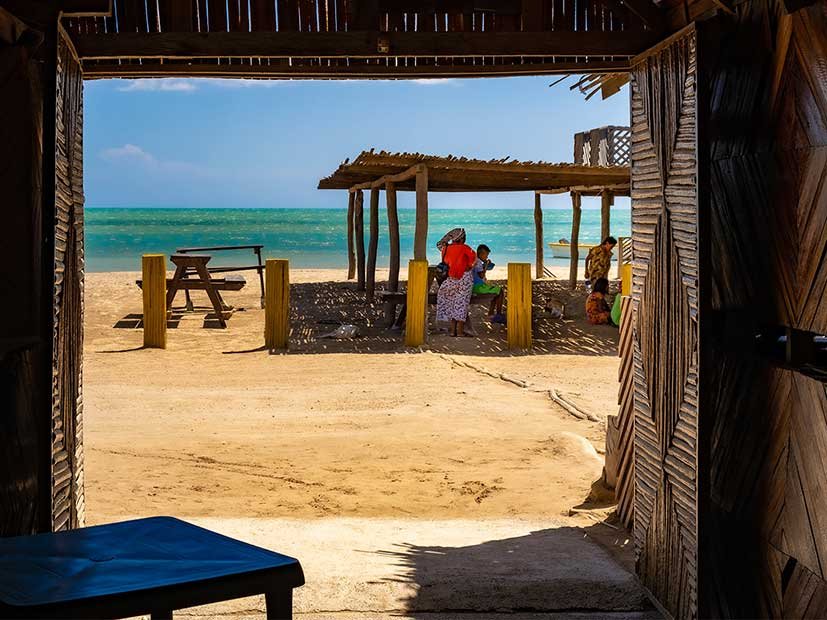
Next day in the morning you will head towards Punta Gallinas with many stops on the way (more on those below). You will spend the night there before heading back. All the meals, transport, and accommodation are included in the price of the tour.
Like with everything, there are cons and pros to taking an organized Cabo de la Vela and Punta Gallinas tour.
The main con is a lack of independence. There were so many stops I wanted to take in order to take amazing photographs – but often I couldn’t as we just kept speeding through the desert.
The most important pro of taking an organized tour is your safety. You will not have to worry about finding accommodation, or places to eat, the guide will stop at all interesting spots, and you will be safe as the guides are local folks who know the place and local customs.
So, tour or no tour? If you want to do it all and also visit Punta Gallinas, a tour is definitely a better option and it will not be much more expensive than if you were doing it on your own. If you book locally. However, if you just want to visit Cabo de la Vela and skip Punta Gallinas you can opt for independent travel. But keep in mind this will involve changes from transport to transport and quite a bit more logistics. Again the choice is yours!
Where to Stay for traveling to Cabo da la Vela and Punta Gallinas
The best place to start your Cabo da la Vela and Punta Gallinas tour is the town of Riohacha.
I do not recommend taking the trip from Santa Marta. You will spend most of the time in the car, and the journey will be very tiring. Even if you take the trip from Riohacha, you will spend a lot of time in the jeep, so adding 3 hours of driving from Santa Marta to Riohacha could make the journey so exhausting you will not enjoy it fully.
If you don’t want to go to Riohacha, you can take the trip from Palomino. Also, Riohacha is a surprisingly nice town, so spending a couple of days there could really enhance your Colombian travels. I was told that Riohacha does not have much to offer and was warned it can be quite a dangerous city. I experienced the opposite!
The best way to get to Riohacha from Santa Marta is by bus from the main Santa Marta bus terminal. It is located outside of the town and you will either have to take a local bus, moto-taxi or taxi to get to the bus station. There are few bus companies operating on this route, so the best is to ask once you have arrived at the station (I have only done the return trip from Riohacha this way). You can get a ticket from the driver, and it will cost around 35,000 COP one way.
The best way to get to Riohacha from Palomino is by bus or colectivo. You can catch the same bus that goes from Santa Marta, and you will be dropped at the bus stop in the center of Riohacha. If you decide to take a colectivo ride (minibus or car), you will most likely be dropped right in front of your hostel (I chose this option), and the ride will be cheaper. I took collectivo and paid 8,000 COP for my ride.
What to expect from the Cabo de la Vela and Punta Gallinas trip
It is definitely an adventure, and La Guajira is like no other place you will ever visit. There are no paved roads, and often it seems like there are no roads at all. You will drive along surreal landscapes where the desert meets the turquoise sea, pass cactus forests, and witness the lives of people who learned how to live in those extreme conditions.
Cabo de la Vala and Punta Gallinas trip will be far from luxurious. In some locations, you will be given a bucket of water to shower with, and you will sleep outside in chinchorro (traditional Wayuu hammock). If you are lucky (or choose your tour provider wisely), you will have running water to shower and electricity for a few hours in the evening.
You will be hot day and night, burn your feet on the sand dunes and fall asleep to the sound of silence under the ceiling of the unpolluted starry sky.
You will encounter indigenous Wayoo people, and see the poverty levels that will break your heart.
As you enter the winding roads of La Guajira and its desert you will encounter many Wayuu kids and adults creating artificial checkpoints/tolls made of ropes and colorful clothes which are meant to stop you on your way. It is expected that you give both children and adults sweets, water, and drinks. I was told this was the case before the trip, but it has to be seen to be believed and understood.
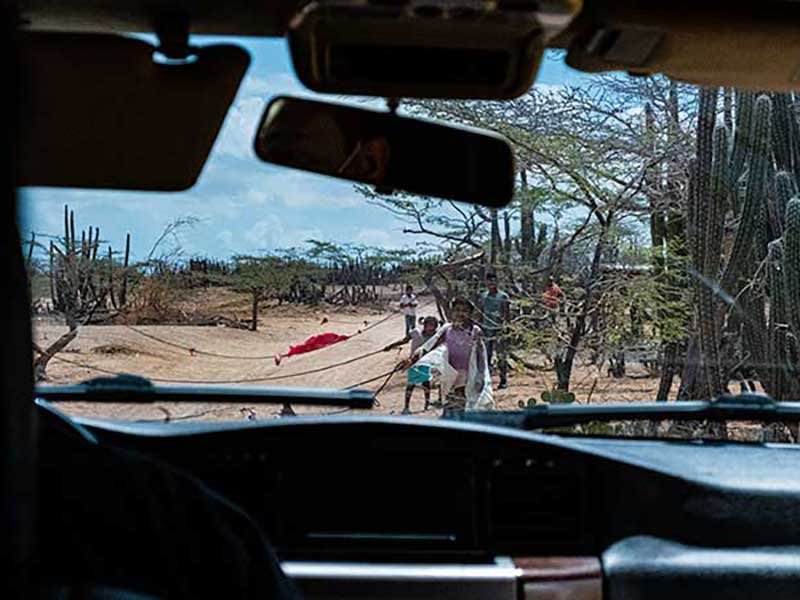
If you book a tour, the driver will take care of it. My driver carried sweets and bags of water and gave it away to the kids.
Many Wayuu are either employed or make some kind of income thanks to growing tourism.
This department is also very neglected by authorities and there is a massive trash issue. I have never seen this much plastic lying around, but I guess when you are troubled if you are going to eat today, the trash disposal is the least of your worries.
What will you see during the Cabo da la Vela and Punta Gallinas trip?
This is a list of places you will see and stop at if you take a 3-day organized trip.
Day 1
On the first day, you will leave Riohacha and head towards Cabo de la Vela. Before arriving at Cabo de la Vela you will stop at some interesting sights, such as:
Manaure Salt Flats (Salinas de Manaure)
It is a pretty impressive place, set in a remote area and originally a nomadic town of Wayuu people. Now Manuare Salt Flats is the leading Colombian salt producer. Beautifully set with the backdrop of crystal clear waters of the Caribbean Sea and with the La Guajira desert to the other side – you will find white salt hills reflecting in the water used for mining the salt.
About 70,000 gallons of seawater is pumped per minute through the brine tank, where salinity intensifies. Then it is moved to ponds, where salt evaporates and crystallizes.
Even if you are not interested in salt production – the site is fascinating, and the views are stunning.
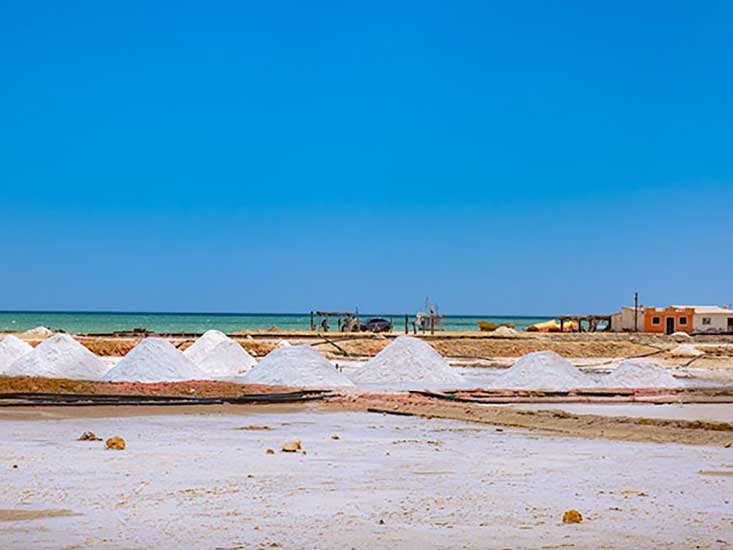
Desert de Carrizal and Cactus Forest
Next, the jeep will take you across the Carrizal desert and cactus forest.
I was absolutely mesmerized by the vastness of the desert and the turquoise sea shimmering at the far back. This was the moment when I just wanted to get out of the car and take hundreds of photos yet I wasn’t able to.
The landscape of La Guajira desert is incredible – it is truly magical.
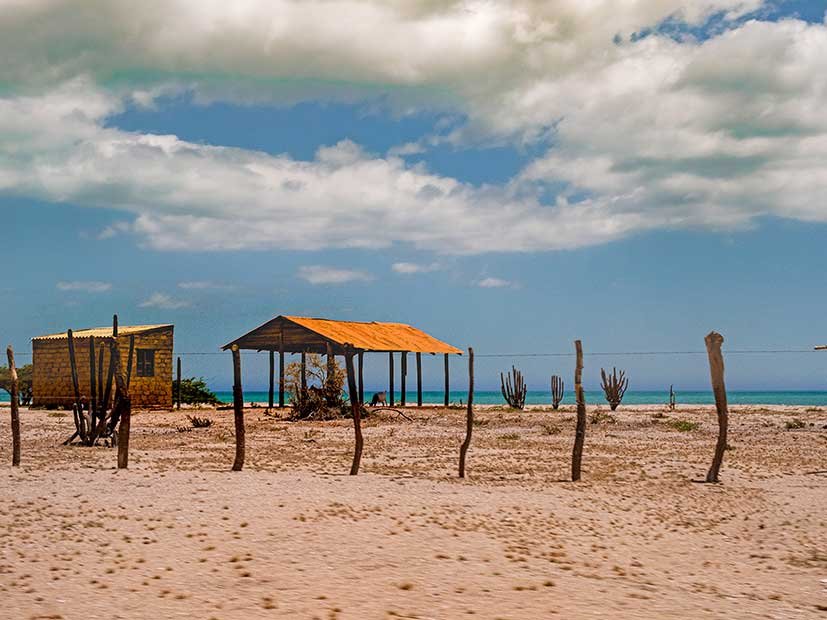
Pilon de Azucar
Pilon de Azucar is a white rock hill that sits between some most amazing beaches near Cabo de la Vela. It is known by Indigenous people as Kamaici, “Lord of the things of the sea”, and it has a deep mythological significance for the Wayúu culture.
The top of the hill can be climbed on foot in around 15 minutes, and from there, you can enjoy the stunning panorama of Cabo de la Vela.
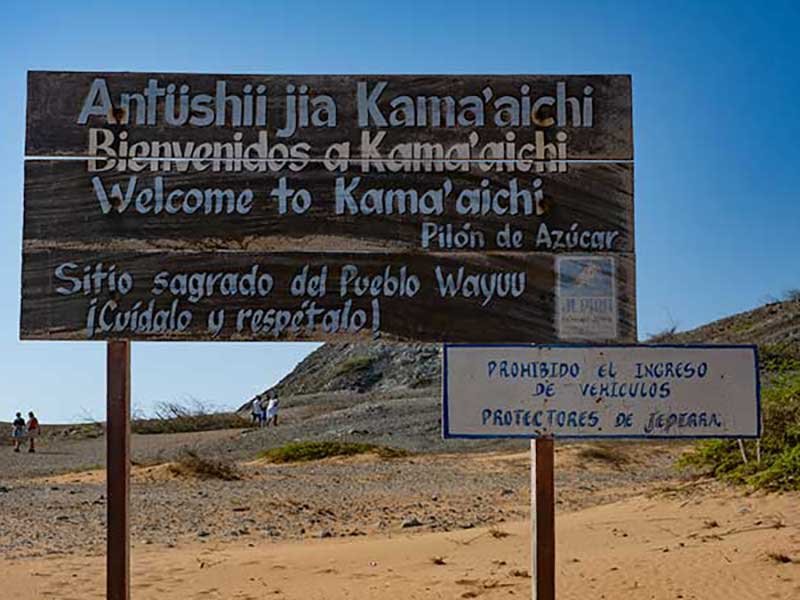
Dorada Beach (Playa del Pilon)
Located right next to Pilon de Azucar, Dorada Beach is one of the most visited and photographed beaches of Cabo de la Vela. It is a gorgeous beach, and you can take a refreshing dip in its clear waters. You will need it by this point. This place is hot!
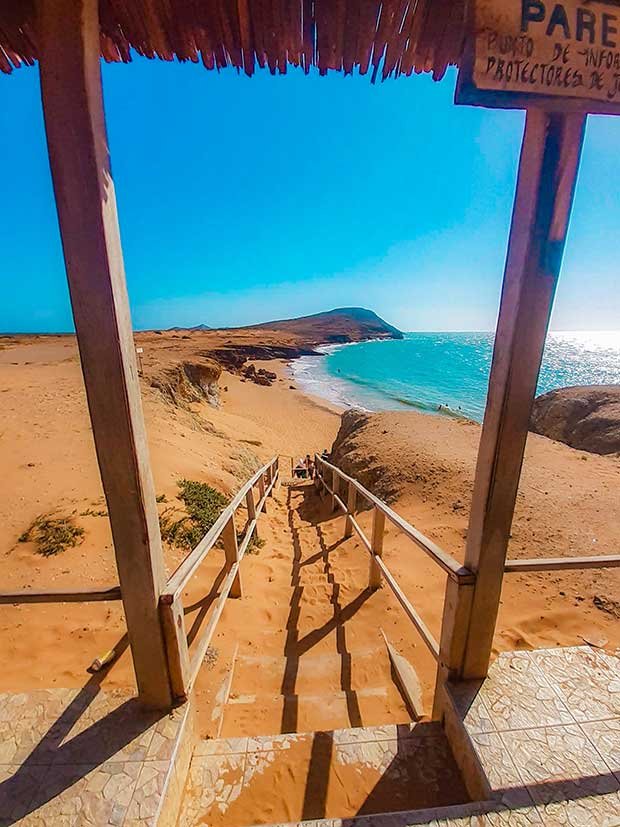
Ojo de Agua Bay
This is a beautiful bay and beach. Its name is derived from the fact that although the Wayuu people suffered from extreme droughts, this place managed to harbor freshwater when the pool of fresh water was discovered here. This is a deeply sacred site for the Wayuu people.
You can also take a walk towards the massive stone extension of the land in the shape of a turtle – La Tortuga.
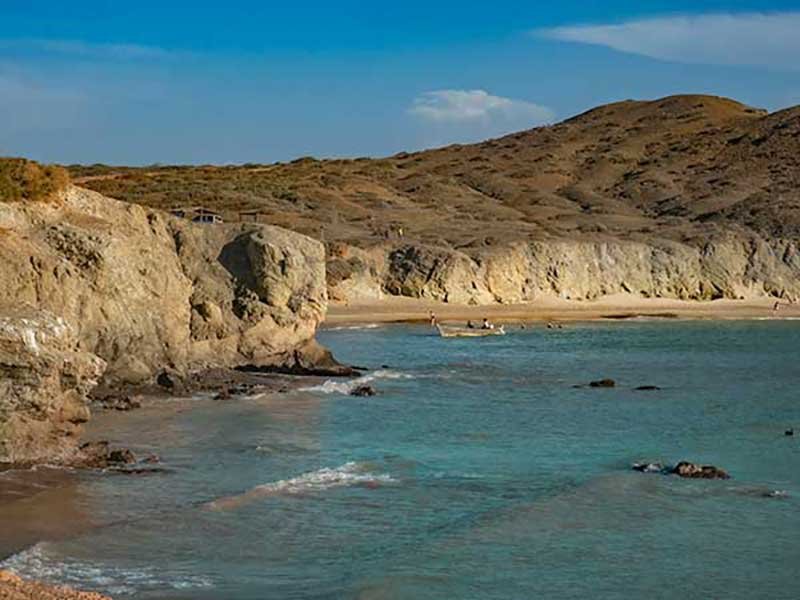
Faro de Cabo de la Vela (Lighthouse)
You will most likely finish your day here watching the sunset from the Faro de Cabo de la Vela.
I had better sunset moments in both La Guajira and Colombia as a whole. All the tourists for the day gather there at sunset, and although it is unquestionably beautiful, it is a very touristy experience.
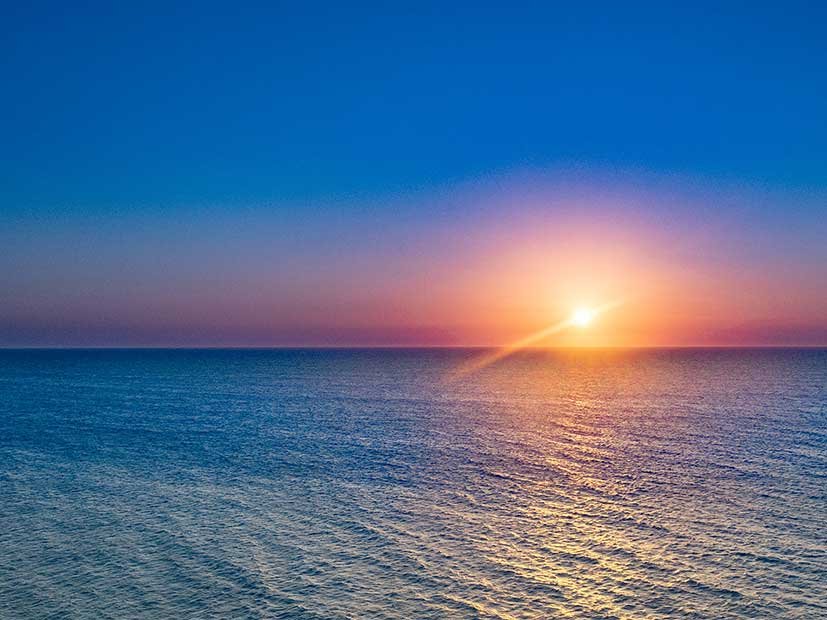
Cabo de la Vela Town and Beach
You will end your day and have your accommodation for the night set at Cabo de la Vela village, and to be honest with you – this was a highlight of the whole day for me.
It is a small town with a couple of restaurants and tiendas set along the main dirt road, a few rancherias with sleeping accommodations, hostels, and a couple of kite schools.
If learning how to kite surf has always been your desire – this is the best place to start!
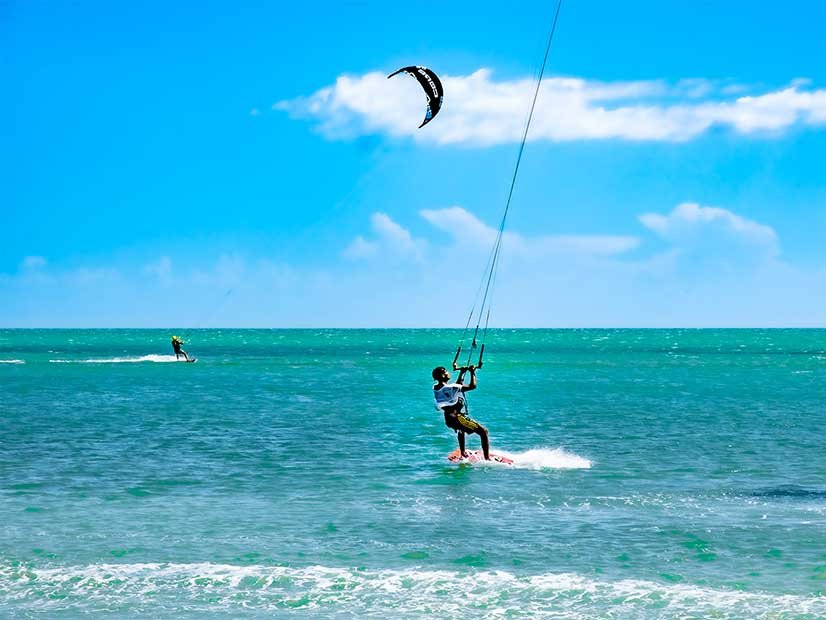
The beach is incredible. It is divine to swim in, and you can watch the acrobatic feats of kitesurfers and drink Cuba Libre after the dark. Yes, you can! I did it!
There is a pizzeria set right on the beach that serves pizzas (obviously) but also beer and a few cocktails. I just couldn’t resist!
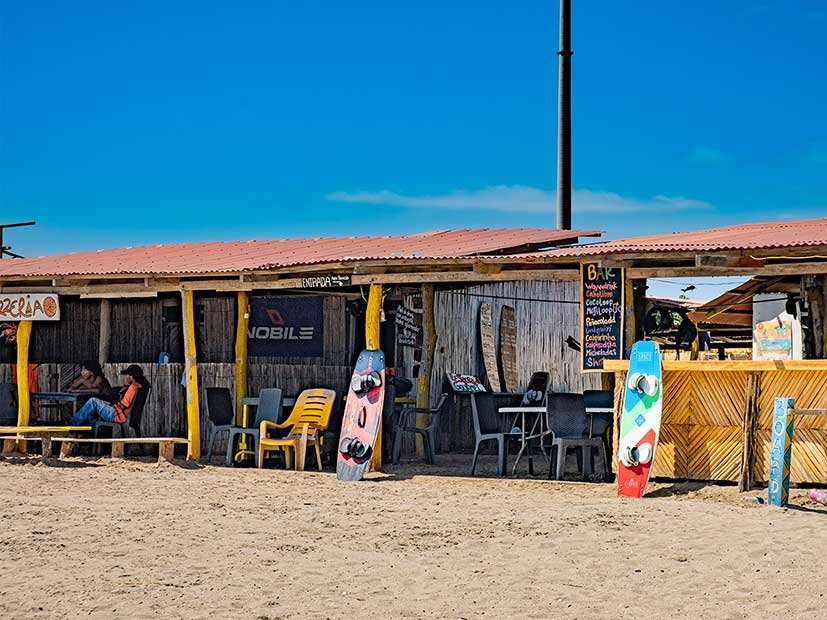
Cabo de la Vela is known as Jepira in Wayuunaiki (Wayoo language) and is a sacred place where the souls of the dead Wayuu come to rest. Please make sure you are respectful of the local communities and refrain from parties and excess drinking/drunkenness.
Day 2
On the second day, you will wake up to the most incredible views!
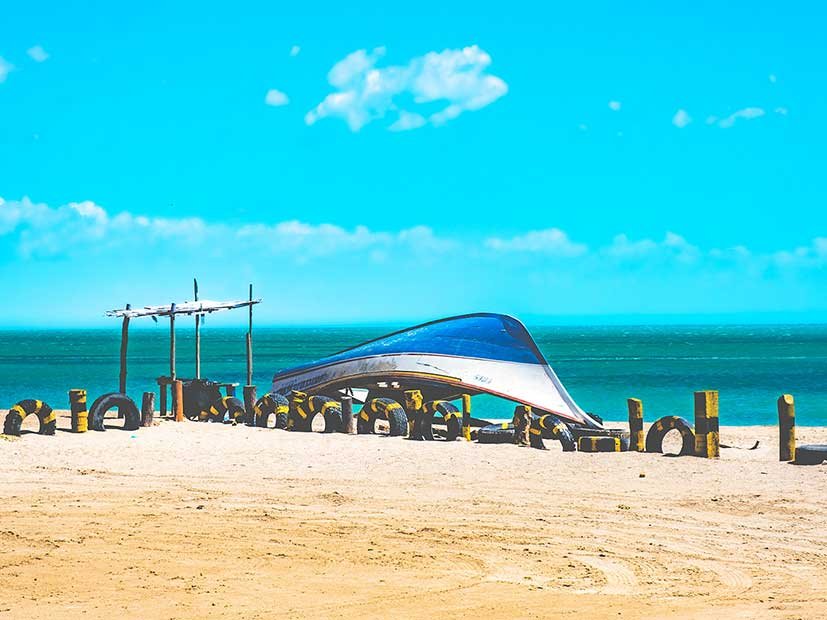
You will set off toward the Punta Gallinas headland but you will have a few stops on the way:
Portete Desert
You will start your day by driving through Portete Desert towards Bahia Honda, passing Bahia Honda desert as well.
Yet again, I was mesmerized by those desert views. This is an incredible landscape with the views of the sea glistening from far away. Surreal!
Bahia Portete
Bahia Portete is part of Kaurrele National Natural Park, and it is one of the most recently established national parks in Colombia.
You will not be able to swim in those waters, but the views are stunning! Visiting this place was definitely one of the highlands of the day. That is before we arrived at Bahia Honda!
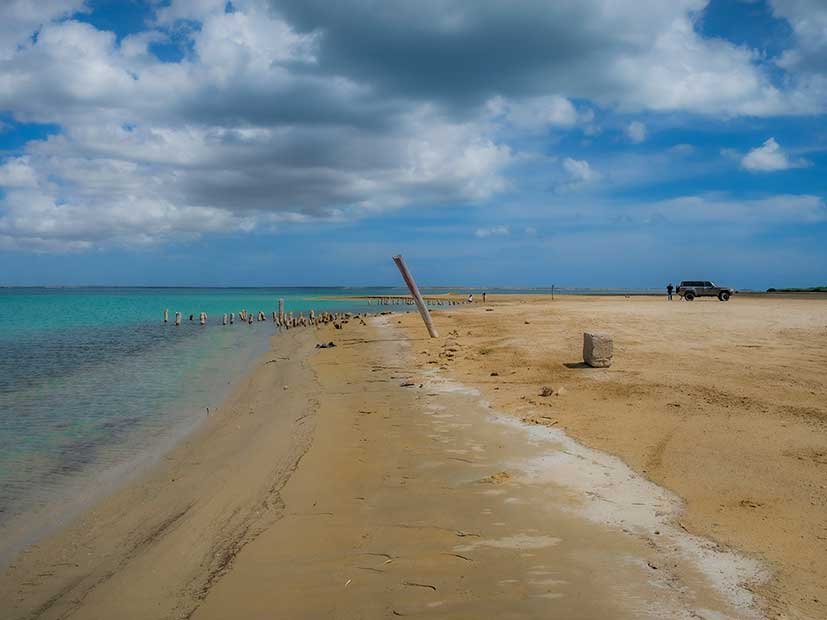
Bahia Honda Beach
This is as close to paradise as it can get.
Not only the beach is incredibly beautiful (I’m running out of adjectives to describe this place) it is also peaceful, remote, and literally, picture-perfect.
I had the best swim in the sea! The sand mixes with tiny seashells, and the views are spectacular!
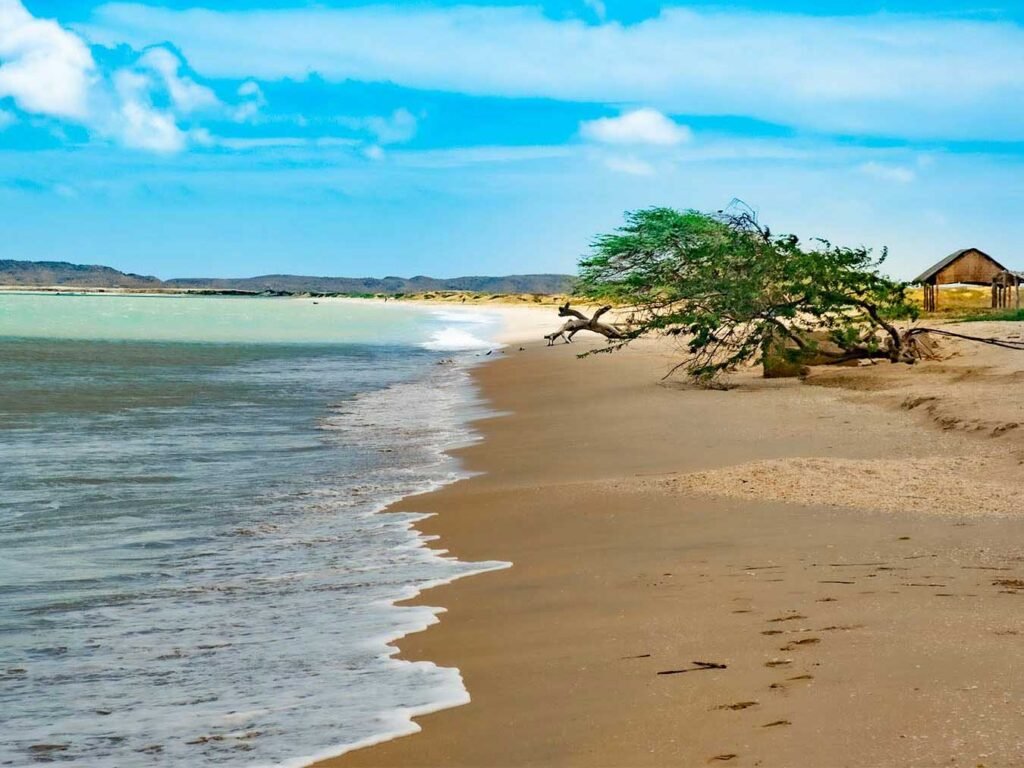
Taroa Dunes and Taroa Beach
What might seem like a mirage actually is true! The slope of the steep sandy dunes descends straight into the Caribbean Sea. It is an out-of-this-world experience.
You can sandboard down its slopes straight to the sea, which seems like a lot of fun I, however, opted for a walk. The sea is pretty rough around here, so you won’t be able to swim. Take a walk to the far right end of the beach, however, and you will be able to enjoy much calmer waters.
On the opposite side of the dunes, you will find a simple restaurant where you can buy some drinks and rest in the shade.
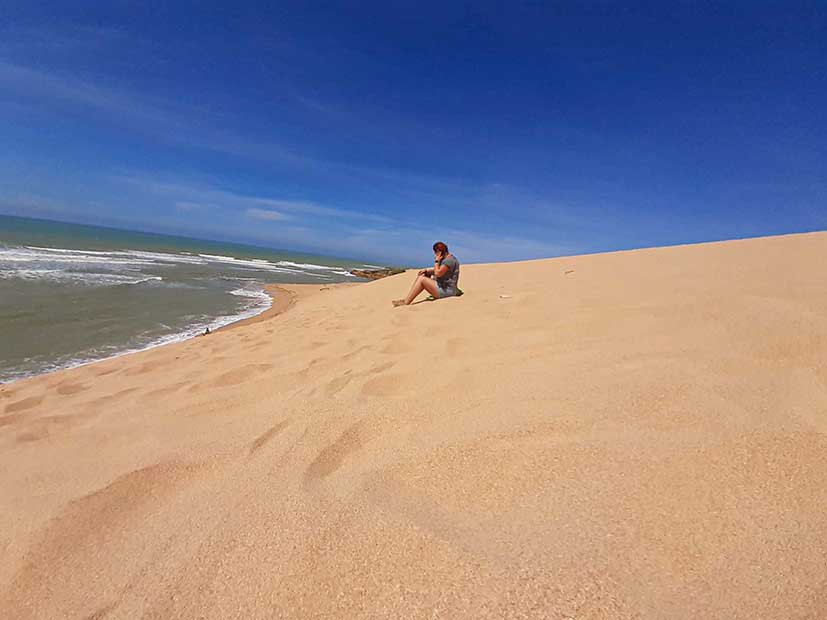
Mirador de Casares (Casares Viewpoint)
From Mirador de Casares you will be able to admire the whole valley of Punta Gallinas. This view is spectacular, and you will be able to fully appreciate the beauty and extent of the land.
This viewpoint is called Casares because the people of the Wayuu usually carry out marriage ceremonies in that place. They also used to carry out reconciling conflicts that existed between the members of the community.
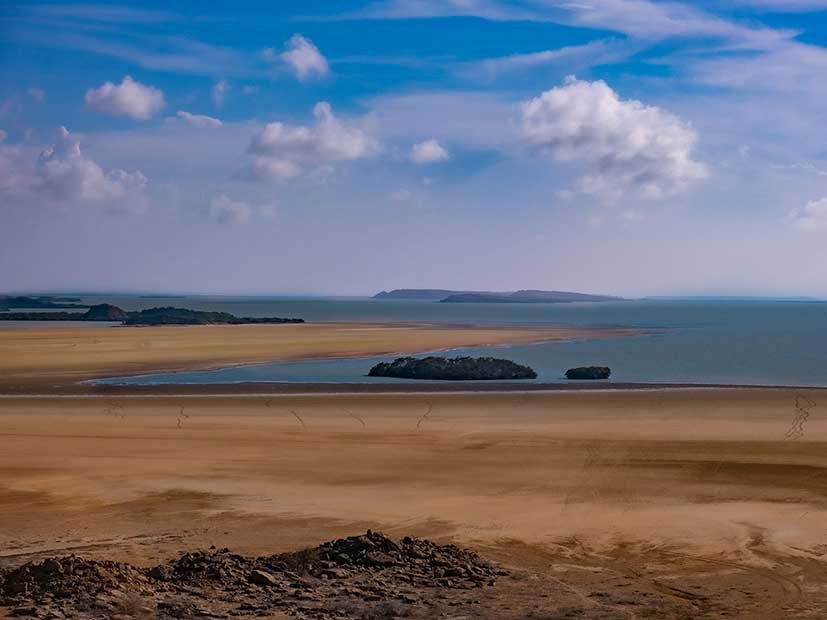
Punta Gallinas Lighthouse
Finally, you will stop at the Faro de Punta Gallinas (Punta Gallinas Lighthouse) – the northernmost point of mainland Colombia and South America. This is where you can take your ‘historical’ photos and admire the rugged and beautiful coastline.
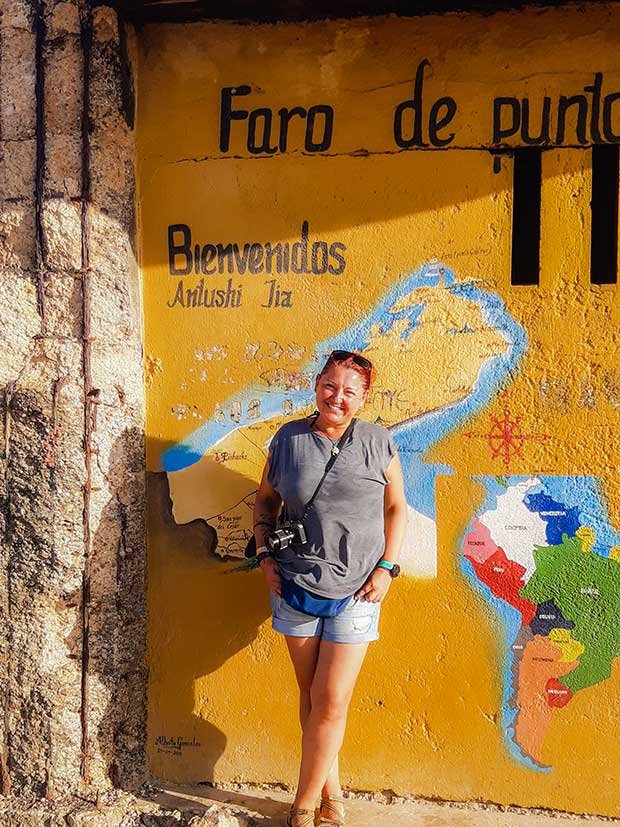
Punta Agujas Beach
Punta Agujas Beach will most likely be your last stop for the day and you will watch the sun setting here.
I liked this sunset much more than the one from Faro de Cabo de la Vela. The beach is also very pretty and you can have a sunset swim in the sea! Perfect end of the eventful day!
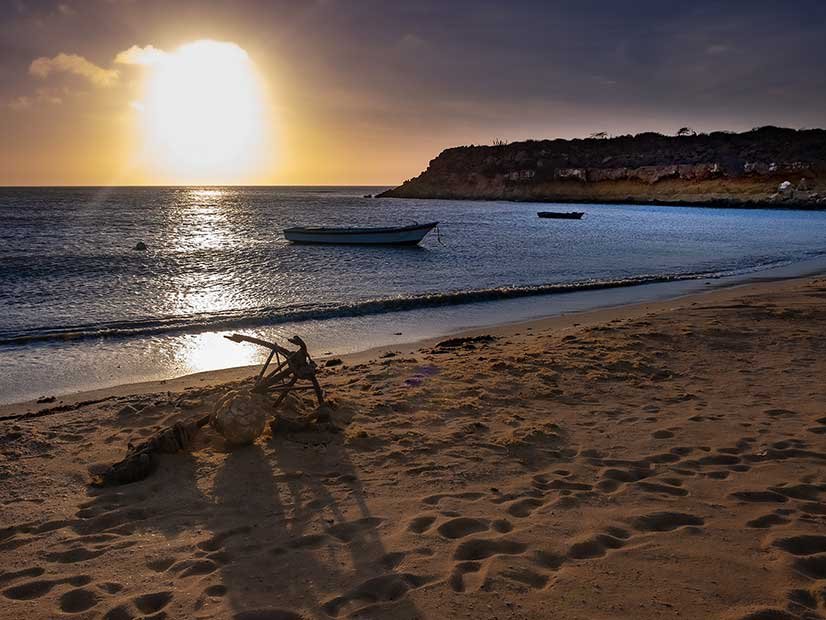
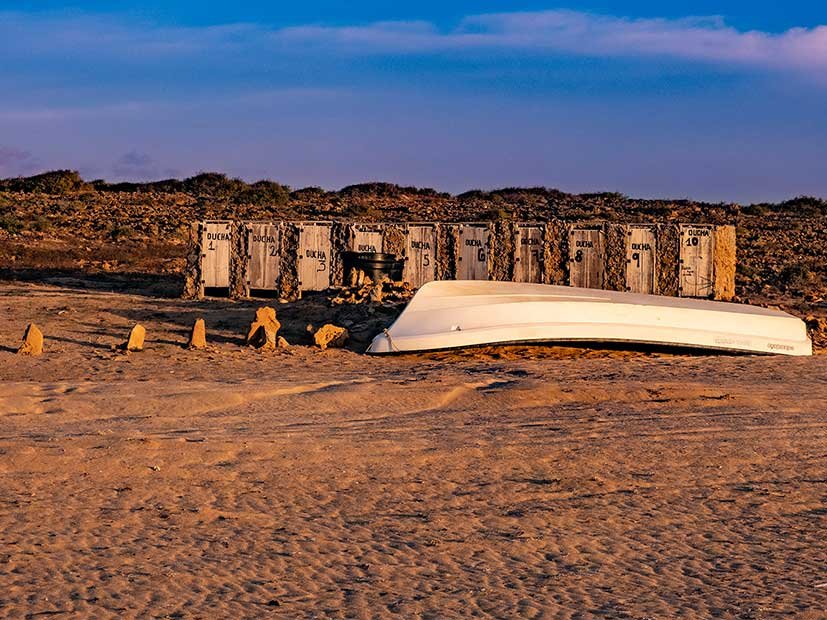
Day 3 is just a return day. It’s a long drive so unlikely you will stop anywhere. You should be back in Riohacha for lunch.
Best Time to Visit La Guajira
The only time I would avoid visiting La Guajira for Cabo de la Vela and Punta Gallinas tours would be October and November. Despite it being a desert area, there is a period of rainfall that occurs in those months, and although it could be cooler, you might encounter a cloudy day, and you won’t be able to fully appreciate the landscapes.
I visited in July – it was hot but pretty dry for the Caribbean.
Tips for traveling to Cabo de la Vela
Those bags are beautiful, and buying one will support the families and this region’s growth. I suggest that if you like the Wayuu bags, buy them from Wayuu women during your trip, rather than getting a fake one in Santa Marta.
What to pack for visiting Cabo de la Vela and Punta Gallinas
Touring La Guajira is an unforgettable experience, yet very much bittersweet. One cannot fully appreciate the natural wonders of the region without noticing the poverty.
I came back a different person. Grateful that I could experience land so beautiful but also extremely thankful for the privilege and ability to make choices about my life. While driving across the desert, I did not see schools, hospitals, or any means those children could have a better life. Having a choice and opportunities is a privilege. We should never forget it!
Where to next?
If you follow my Colombia itinerary you are probably you are heading towards Cartagena next! Cartagena is one of the must-see places to visit in Colombia and if you visiting for the first time – here is a breakdown of all the best places to stay in Cartagena for first-time travelers.
If you are heading straight to Rincon del Mar, be ready to never want to leave! It is my favorite beach town in Colombia! And on the way be sure to stop for a few days in Santa Marta. And while there you will definitely not wanna miss a trip to magical Minca!
Oh and if you are planning on visiting the Colombia coffee region be sure to read my coffee region guide as well as guides to towns like Salento, Jardin, or Filandia.
Happy Colombia travels!
Pati
If you have any questions or comments head over to my awesome free FB Group for Solo Budget Travellers! You can connect with me and become part of a community of like-minded travelers! I will answer all your questions! You can also follow me on Instagram!
If you found this post to be of value to you you can also buy me a coffee by clicking the blue Support Me button floating freely somewhere on the page or by clicking here. This way I will know that you found this post valuable and will allow me to keep producing those articles.

